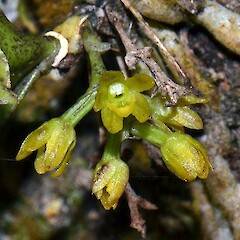Drymoanthus adversus
Common name
fleshy tree orchid
Synonyms
Sarcochilus adversus Hook.f.; Sarcochilus breviscapa Col.
Family
Orchidaceae
Flora category
Vascular – Native
Endemic taxon
Yes
Endemic genus
No
Endemic family
No
Structural class
Orchids
NVS code
The National Vegetation Survey (NVS) Databank is a physical archive and electronic databank containing records of over 94,000 vegetation survey plots - including data from over 19,000 permanent plots. NVS maintains a standard set of species code abbreviations that correspond to standard scientific plant names from the Ngä Tipu o Aotearoa - New Zealand Plants database.
DRYADV
Chromosome number
2n = 76
Current conservation status
The conservation status of all known New Zealand vascular plant taxa at the rank of species and below were reassessed in 2017 using the New Zealand Threat Classification System (NZTCS) – more information about this can be found on the NZTCS website. This report includes a statistical summary and brief notes on changes since 2012 and replaces all previous NZTCS lists for vascular plants.
Please note, threat classifications are often suggested by authors when publications fall between NZTCS assessment periods – an interim threat classification status has not been assessed by the NZTCS panel.
- Conservation status of New Zealand indigenous vascular plants, 2017 . 2018. Peter J. de Lange, Jeremy R. Rolfe, John W. Barkla, Shannel P. Courtney, Paul D. Champion, Leon R. Perrie, Sarah M. Beadel, Kerry A. Ford, Ilse Breitwieser, Ines Schönberger, Rowan Hindmarsh-Walls, Peter B. Heenan and Kate Ladley. Department of Conservation. Source: NZTCS and licensed by DOC for reuse under the Creative Commons Attribution 4.0 International licence.
2017 | Not Threatened
Previous conservation statuses
2012 | Not Threatened
2009 | Not Threatened
2004 | Not Threatened
Distribution
Endemic. New Zealand: North Island, South Island (uncommon in the southern two-thirds where it is virtually replaced by D. flavus St George et Molloy), Chatham Islands.
Habitat
Coastal to montane. Epiphytic, rupestral or terrestrial. Mostly on the trunks and branches of shrubs and taller forest trees but also on rocks, cliff faces, banks and fallen, moss covered logs.
Detailed description
Conspicuous tufted epiphyte of trunks and branches relatively clean of other epiphytic plants. Occasionally found on rock outcrops and cliff faces. Forming branched, leafy, tufts (40)–120–(150) mm diameter, with many white to brown, cord-like roots firmly attached to substrate. Lower parts covered in old leaf and inflorescence bases. Leaves (40)–60–(90) × 15–20–(30) mm, dark green, occasionally purple spotted, fleshy, elliptic, oblong, elliptic-oblong, with obtuse to emarginate, flat or twisted apices. Inflorescences racemose arising from or below the leaves, usually several per season; up to 80 mm long, bearing (1)–6–(20) flowers. Flowers green or greenish-white, flecked with red, maroon or purple. Sepals and petals subequal, spreading widely but projecting forwards and inwards to form a cup. Dorsal sepal 3.5–4.5 × 1.5–2.0 mm, lateral sepals shorter, petals 2.5–3.5 × 1.5–1.8 mm. Labellum 2.5 × 2.0 mm, projected forwards, immobile, cupular, deeply channelled, mid-lobe evident only as a cucullate apex; lateral lobes forming sides of clog-shaped structure and each furnished with an internally projecting, partly transverse ridge, distal portion distinctly thickened, fleshy, bearing two prominent upright, flattened calli. Capsule 20 × 6 mm, broadly cylindrical to fusiform, green, usually without spots.
Manaaki Whenua Online Interactive Key
Similar taxa
Allied to Drymoanthus flavus from which it differs by its larger size, thicker (rather than thinner), distinctly fleshy (rather than coriaceous), elliptic to oblong (rather than elliptic to lanceolate), glossy (rather than dull), obtuse to emarginate (rather than acute), mostly dark green, rarely spotted (rather than pale green and spotted) leaves, green to greenish-white flowers flecked with red, maroon or purple (rather than greenish-yellow flowers lacking spots), cupular (rather than broadly trough-shaped) labellum with the distal portion bearing two prominent, upright, flattened calli (rather than none), uniformly green, rarely spotted (rather than spotted) capsules, and tetraploid (rather than diploid) chromosome number.
Flowering
September–January
Flower colours
Green, White
Fruiting
November–May
Life cycle
Minute seeds are wind dispersed (Thorsen et al., 2009).
Propagation technique
Plants can be grown by strapping them to a log, or wood slab and placing them suspended in a sheltered, warm position. Water frequently until well established. Should not be removed from the wild.
Etymology
adversus: From the Latin adversus ‘turned towards’, ‘before’ or ‘opposite’
Attribution
Fact Sheet prepared for NZPCN by P.J. de Lange (1 April 2007). Description adapted from Moore and Edgar (1970)
References and further reading
Moore LB, Edgar E. 1970. Flora of New Zealand, Volume II. Indigenous Tracheophyta: Monocotyledones except Gramineae. Government Printer, Wellington, NZ. 354 p.
Thorsen MJ, Dickinson KJM, Seddon PJ. 2009. Seed dispersal systems in the New Zealand flora. Perspectives in Plant Ecology, Evolution and Systematics 11: 285–309. https://doi.org/10.1016/j.ppees.2009.06.001.
NZPCN Fact Sheet citation
Please cite as: de Lange, P.J. (Year at time of access): Drymoanthus adversus Fact Sheet (content continuously updated). New Zealand Plant Conservation Network. https://www.nzpcn.org.nz/flora/species/drymoanthus-adversus/ (Date website was queried)





















